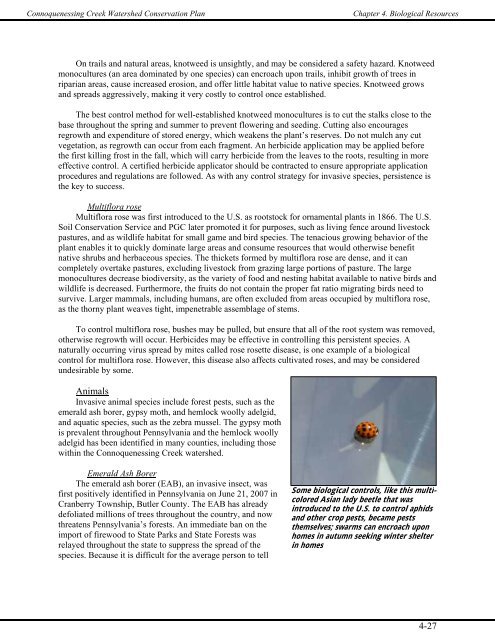CHAPTER 4 - Western Pennsylvania Conservancy
CHAPTER 4 - Western Pennsylvania Conservancy
CHAPTER 4 - Western Pennsylvania Conservancy
Create successful ePaper yourself
Turn your PDF publications into a flip-book with our unique Google optimized e-Paper software.
Connoquenessing Creek Watershed Conservation Plan<br />
Chapter 4. Biological Resources<br />
On trails and natural areas, knotweed is unsightly, and may be considered a safety hazard. Knotweed<br />
monocultures (an area dominated by one species) can encroach upon trails, inhibit growth of trees in<br />
riparian areas, cause increased erosion, and offer little habitat value to native species. Knotweed grows<br />
and spreads aggressively, making it very costly to control once established.<br />
The best control method for well-established knotweed monocultures is to cut the stalks close to the<br />
base throughout the spring and summer to prevent flowering and seeding. Cutting also encourages<br />
regrowth and expenditure of stored energy, which weakens the plant’s reserves. Do not mulch any cut<br />
vegetation, as regrowth can occur from each fragment. An herbicide application may be applied before<br />
the first killing frost in the fall, which will carry herbicide from the leaves to the roots, resulting in more<br />
effective control. A certified herbicide applicator should be contracted to ensure appropriate application<br />
procedures and regulations are followed. As with any control strategy for invasive species, persistence is<br />
the key to success.<br />
Multiflora rose<br />
Multiflora rose was first introduced to the U.S. as rootstock for ornamental plants in 1866. The U.S.<br />
Soil Conservation Service and PGC later promoted it for purposes, such as living fence around livestock<br />
pastures, and as wildlife habitat for small game and bird species. The tenacious growing behavior of the<br />
plant enables it to quickly dominate large areas and consume resources that would otherwise benefit<br />
native shrubs and herbaceous species. The thickets formed by multiflora rose are dense, and it can<br />
completely overtake pastures, excluding livestock from grazing large portions of pasture. The large<br />
monocultures decrease biodiversity, as the variety of food and nesting habitat available to native birds and<br />
wildlife is decreased. Furthermore, the fruits do not contain the proper fat ratio migrating birds need to<br />
survive. Larger mammals, including humans, are often excluded from areas occupied by multiflora rose,<br />
as the thorny plant weaves tight, impenetrable assemblage of stems.<br />
To control multiflora rose, bushes may be pulled, but ensure that all of the root system was removed,<br />
otherwise regrowth will occur. Herbicides may be effective in controlling this persistent species. A<br />
naturally occurring virus spread by mites called rose rosette disease, is one example of a biological<br />
control for multiflora rose. However, this disease also affects cultivated roses, and may be considered<br />
undesirable by some.<br />
Animals<br />
Invasive animal species include forest pests, such as the<br />
emerald ash borer, gypsy moth, and hemlock woolly adelgid,<br />
and aquatic species, such as the zebra mussel. The gypsy moth<br />
is prevalent throughout <strong>Pennsylvania</strong> and the hemlock woolly<br />
adelgid has been identified in many counties, including those<br />
within the Connoquenessing Creek watershed.<br />
Emerald Ash Borer<br />
The emerald ash borer (EAB), an invasive insect, was<br />
first positively identified in <strong>Pennsylvania</strong> on June 21, 2007 in<br />
Cranberry Township, Butler County. The EAB has already<br />
defoliated millions of trees throughout the country, and now<br />
threatens <strong>Pennsylvania</strong>’s forests. An immediate ban on the<br />
import of firewood to State Parks and State Forests was<br />
relayed throughout the state to suppress the spread of the<br />
species. Because it is difficult for the average person to tell<br />
Some biological controls, like this multicolored<br />
Asian lady beetle that was<br />
introduced to the U.S. to control aphids<br />
and other crop pests, became pests<br />
themselves; swarms can encroach upon<br />
homes in autumn seeking winter shelter<br />
in homes<br />
4-27














